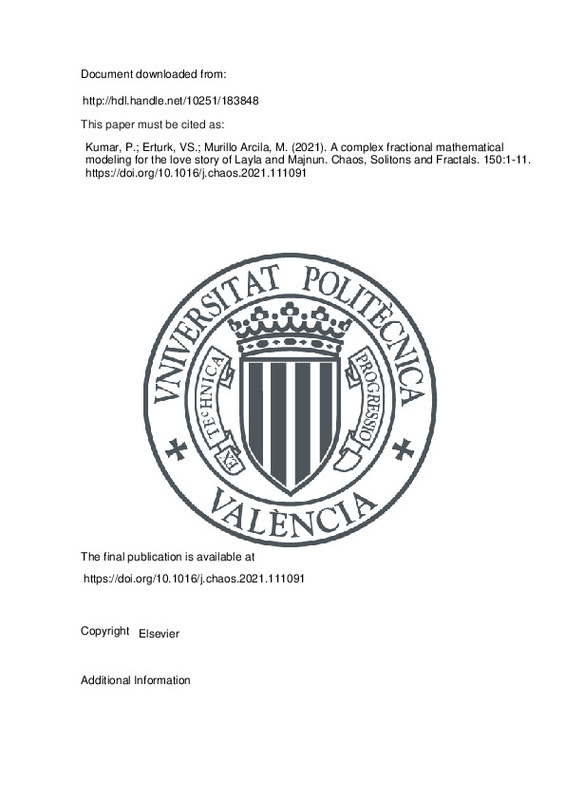JavaScript is disabled for your browser. Some features of this site may not work without it.
Buscar en RiuNet
Listar
Mi cuenta
Estadísticas
Ayuda RiuNet
Admin. UPV
A complex fractional mathematical modeling for the love story of Layla and Majnun
Mostrar el registro sencillo del ítem
Ficheros en el ítem
| dc.contributor.author | Kumar, Pushpendra
|
es_ES |
| dc.contributor.author | Erturk, Vedat Suat
|
es_ES |
| dc.contributor.author | Murillo Arcila, Marina
|
es_ES |
| dc.date.accessioned | 2022-07-05T18:05:46Z | |
| dc.date.available | 2022-07-05T18:05:46Z | |
| dc.date.issued | 2021-09 | es_ES |
| dc.identifier.issn | 0960-0779 | es_ES |
| dc.identifier.uri | http://hdl.handle.net/10251/183848 | |
| dc.description.abstract | [EN] In this article, we provide numerical simulations to show the importance and the effects of fractional order derivatives in psychological studies. As it is well-known, complex variables are more realistic for defining structures in different cases. In this paper, we evidence that such dynamics become more realistic when we use fractional derivatives. We study a non-integer order, non-linear mathematical model for defining a love story of Layla and Majnun (a couple in a romantic relationship). We exemplify all necessary practical calculations to study this serious psychological phenomena. The existence of the unique solution for the given model is exhibited. We use a very recent and strong modified Predictor-Corrector algorithm to evaluate the model structure. Stability of the proposed method is also given. We exemplify that the given complex fractional model is more realistic and represents reality more closely. The proposed model is very basic, significant, and efficient at introducing distinct natures by only replacing one control parameter. In this study, we found that in some of the cases there are stable limit cycles, in some cases periodic behaviours and sometimes transiently chaotic solutions exist which cannot be observed for integer order models at same parameter values. The principal contribution of this article is to exhibit the importance of non-integer order derivatives for analysing complex dynamics. The use of complex variables makes this study more effective because they have both magnitude and phase to better explore the love and can describe different emotions such as coexisting love and hate. (c) 2021 Elsevier Ltd. All rights reserved. | es_ES |
| dc.language | Inglés | es_ES |
| dc.publisher | Elsevier | es_ES |
| dc.relation.ispartof | Chaos, Solitons and Fractals | es_ES |
| dc.rights | Reconocimiento - No comercial - Sin obra derivada (by-nc-nd) | es_ES |
| dc.subject | Psychological modelling | es_ES |
| dc.subject | Complex variables | es_ES |
| dc.subject | Fractional mathematical model | es_ES |
| dc.subject | Numerical algorithm | es_ES |
| dc.subject | New generalised Caputo type fractional | es_ES |
| dc.subject | Derivative | es_ES |
| dc.subject.classification | MATEMATICA APLICADA | es_ES |
| dc.title | A complex fractional mathematical modeling for the love story of Layla and Majnun | es_ES |
| dc.type | Artículo | es_ES |
| dc.identifier.doi | 10.1016/j.chaos.2021.111091 | es_ES |
| dc.rights.accessRights | Abierto | es_ES |
| dc.contributor.affiliation | Universitat Politècnica de València. Departamento de Matemática Aplicada - Departament de Matemàtica Aplicada | es_ES |
| dc.description.bibliographicCitation | Kumar, P.; Erturk, VS.; Murillo Arcila, M. (2021). A complex fractional mathematical modeling for the love story of Layla and Majnun. Chaos, Solitons and Fractals. 150:1-11. https://doi.org/10.1016/j.chaos.2021.111091 | es_ES |
| dc.description.accrualMethod | S | es_ES |
| dc.relation.publisherversion | https://doi.org/10.1016/j.chaos.2021.111091 | es_ES |
| dc.description.upvformatpinicio | 1 | es_ES |
| dc.description.upvformatpfin | 11 | es_ES |
| dc.type.version | info:eu-repo/semantics/publishedVersion | es_ES |
| dc.description.volume | 150 | es_ES |
| dc.relation.pasarela | S\455727 | es_ES |







![[Cerrado]](/themes/UPV/images/candado.png)

